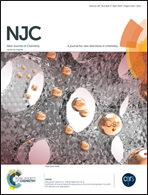Synthesis and characterization of siloxane photopolymers used for microfluidic devices
Abstract
A linear ABA type diacrylic macromer containing an amphiphilic backbone composed of a siloxane block (SiO) and two polyoxyethylene blocks (EO) was synthesized and subsequently photopolymerized and copolymerized with a polyoxyethylene diacrylate. The kinetics of the photopolymerization was monitored by rt-FTIR, confirming the reactivity of the acrylic functionalities. The obtained polymers were then characterized by DMTA analyses and showed interesting biphasic morphology with two Tgs attributable to the EO domains and to the SiO domains. Swelling in different solvents was also tested: compared to siloxane acrylates, the introduction of EO enhanced the chemical resistance of the polymer to most solvents, excluding water. Surface analyses showed that the incorporation of both hydrophobic siloxane groups and hydrophilic polyoxyethylene groups into the networks is a successful method for controlling their surface; due to the preferential segregation of the SiO blocks at the air interface, the wettability of the polymers with water is very low, but can change depending on the environment. Compatibility toward DNA amplification reaction was successfully tested. As the possibility of fast, accurate, and cheap reproducibility of microdevices by liquid phase photopolymerization increases the attractiveness of the polymer, this material is a good alternative to polydimethylsiloxane for the fabrication of microfluidic chips for biological analysis purposes.


 Please wait while we load your content...
Please wait while we load your content...